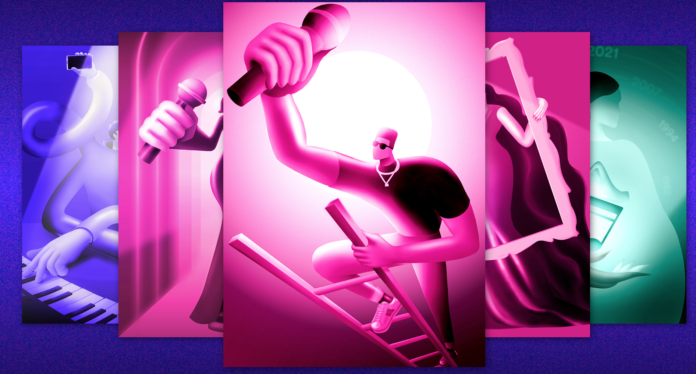There aren’t many large tech companies as transparent with their data as Spotify. The bar is pathetically low, but Spotify clears it considerably with the launch of Loud & Clear annual reports in 2021. While clarity regarding the streaming service’s operation is provided, the reports exist mainly to defend Spotify’s claims of their positive impact on artists’ chances of commercial success.
That being said, one of the most crucial aspects of Spotify’s Loud & Clear reports is the analysis of artist earnings on their platform. With more data to look at, journalists, artists, and other music industry participants can better answer the question, “Has Spotify made music-making careers more viable?”
One of the streaming giant’s biggest claims in the 2022 version of Loud & Clear is more than a quarter of professional and professionally-aspiring artists generated $10,000 or more on their platform in 2021. What’s shaky about this claim, aside from generated revenue not equating to take-home pay, is the criteria determining who is and is not a “professional.”
When Does a Musical Artist Go From Hobbyist To “Professional”?
In the 2022 Loud & Clear FAQ, Spotify offers two benchmarks used to label artists as professional or professionally aspiring: minimums of 10 songs released on Spotify and 10,000 monthly listeners. While Music Business Worldwide exercises healthy skepticism of the latest Loud & Clear report, they end their review presenting Spotify’s definition of “professionally aspiring” unchallenged.
The first benchmark of 10 published songs equates output to professional intent. Fair. Using monthly listeners in the same vein? Much less reliable. Failing to have 10,000 listeners says nothing about an artist’s professional merit other than their streaming revenue is paltry. At face value, listener counts cannot differentiate between musical artists with marketing struggles, alternative marketing goals, or no streaming-based marketing goals at all.
(Read Ari Herstand’s excellent breakdown of this flaw and more on Spotify’s 2023 Loud & Clear report.)
The implication of removing audience size as a professional artistry requirement is big: the percentage of “professional” acts generating — once again, not taking home — at least five figures via Spotify (52,600 total artists) would drop from 26 to two.
How Spotify’s Loud & Clear Misrepresents The Reality of Independent Music
Even if it’s a reach to label all 2.6 million artists with 10 or more songs on Spotify “professional,” it’s hard to imagine even half of that prolific-enough group admitting to having no professional aspirations. As speculative as that last sentence was, so is Spotify’s conclusion that millions of artists with two EPs worth of songs have no intentions of being full-time artists. If the true number of “professional and professionally aspiring” artists is closer to 2.6 million than Spotify’s 200,000 estimate, the share of artists on their platform making worthwhile money would be much less flattering.
A blessing and a curse of digital music streaming is the lowering of barriers to entry. The number of commercial artists, songwriters, and producers is growing at a rate that puts pressure on the amount of revenue there is to spread around.
Also commenting on Spotify’s latest Loud & Clear report is Tatiana Cirisano of Midia Research who astutely points out the need for innovation around fan support to complete the paradigm shift away from a top-heavy music industry. But how does that happen?
While indie music blogs are still relevant (and perhaps even more important in today’s commodified music media landscape) and more marketing tools are available to artists than ever before, resources and power in the recorded music industry are still overwhelmingly concentrated in the hands of very few power brokers.
As indie artists custom build their careers brick by brick, major labels are moving like aggressive commercial real estate developers eating up market share and rapidly producing serviceable, cookie-cutter assets. Sure, you might get robbed monthly for rent and contribute to further inequality, but everything happens around the shiny new uptown high-rises. The FOMO is real, even in the midst of many acts removing their music from Spotify over Daniel Ek’s recent military investments. Serious indie artists are pouring hundreds if not thousands of dollars a year into Spotify marketing services, and major label spending toward the same goal is orders of magnitude higher per artist.
Until the average fan has access to better infrastructure (and better wages, frankly) to directly support their favorite artists, streaming platforms and the major labels are just giving more ants smaller crumbs of the pie. Every once in a while, the greediest pie eaters buy an ant hill when it gets too big.
Spotify is an innovative, game-changing company. What it hasn’t changed, however, are the fundamental outcomes of the music industry: a few people get a lot, a lot of people get a little, and most don’t get enough to last long.
Loud & Clear 2022 says a lot, but the report confirms these realities despite its confident optimism. If Spotify is serious about helping serious musical creatives find a way, its understanding of a “professional” artist can’t exclude most of them.
UPDATE 3/25/2025: Edited for typo and source citations
UPDATE 7/30/2025: Edited for structure; general content refresh including mention of artists removing their music from Spotify due to Daniel Ek’s investment in defense tech firm Helsing
